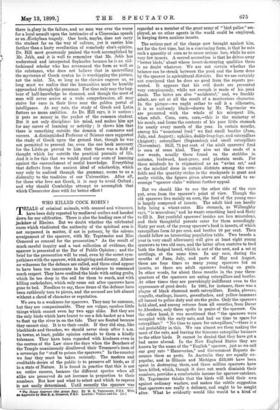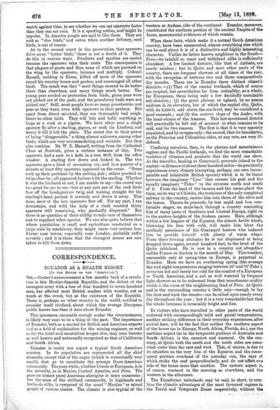WHO KILLED COCK ROBIN ? T RIALS of criminal animals, with
counsel and witnesses, have been duly reported by mediaeval scribes and handed down for our edification. There is also the leading case of the jackdaw of Rheims. But we doubt whether the celebrated curse which vindicated the authority of the spiritual arm is not surpassed in matter, if not in potency, by the solemn arraignment of the sparrow, with Mr. Tegetmeier and Miss Ormerod as counsel for the prosecution.* As the result of much careful inquiry and a vast collection of evidence, the sparrow is presented at the Bar of Public Opinion ; and the brief for the prosecution will be read, even by the secret sym- pathisers with the sparrow, with misgiving and dismay. Almost no witnesses for the defence are called, and those cited appear to have been too inaccurate in their evidence to command much respect. They have credited the birds with eating grubs, which lie too deep in the soil for them to reach, and with killing cockchafers, which only come out after sparrows have gone to bed. Needless to say, these items of the defence have been ruthlessly torn to pieces, and the accused are left almost without a shred of character or reputation.
We own to a weakness for sparrows. They may be common, but they are companionable. They are vulgar, careless little things which cannot even lay two eggs alike. But they are the only birds which have learnt to use a fish-basket as a boat to float up the river in on the tide. They are flouted because they cannot sing. It is to their credit. If they did sing, like blackbirds and thrushes, we should never sleep after 5 a.m. In towns, at least, public opinion extends to them a kindly tolerance. They have been regarded with kindness even in the centres of the Law since the days when the Benchers of the Temple unanimously disallowed their Treasurer's item of a sovereign for "stuff to poison the sparrows." In the country we fear they must be taken seriously. The modern and creditable desire of the public is to preserve all birds, as if in a state of Nature. It is found in practice that this is not an entire success, because the different species when all alike are preserved do not increase in proportion to their numbers. But how and what to select and which to repress is not easily deterniined. Until recently the sparrow was • The House Sparrow (the Avian Rat). By M. B. Tegetmeier. F.Z.S. With an Appendix by Miss B. A. Ormerod, F.B.S. London : Vinton and Co. fig.) regarded as a member of the great army of "bird police" em- ployed, as no other agents in the world could be employed, in keeping down noxious insects.
The serious part of the charge now brought against him, not for the first time, but in a convincing form, is that he eats such a quantity of corn as to cause serious loss, while he eats very few insects. A second accusation is that he drives away "better birds," about whose insect-destroying qualities there is no doubt whatever. We are not certain whether the balance can be struck between the good and the harm done by the sparrow in agricultural districts. But we are certainly not convinced that he does no good from the reports pre- sented. It appears that his evil deeds are presented very conspicuously, while not enough is made of his good deeds. The latter are also "accidental," and, we frankly admit, are not at all the result of a meritorious character. In the picture—we ought rather to call it a silhouette, it is so uniformly black—drawn by Mr. Tegetmeier we are presented with the whole of his misspent life, when adult. Corn, corn, corn,—this is the mainstay of his meals, and forms the contents of his poor little stomach for nearly every month of the year. In certain months, among his "occasional food" we find small beetles (June, July, and August) ; aphides, daddy-long-legs, and caterpillars (August) ; caterpillars (September), and small caterpillars (November). Still, 75 per cent. of the adult sparrows' food is corn of some kind. They also eat the seeds of a few weeds, usually those found on the stubbles in autumn, birdweed, knot-grass, and plantain seeds. For these misdeeds he is stigmatised as an "avian rat," and as the mischief done in certain districts among the corn- fields and the quantity stolen in the stackyards is great and easily visible, the figures given above are calculated to en- courage "sparrow clubs" without further appeal.
But we should like to see the other side of the case put, even from the sparrow's point of view. Though the old sparrows live mainly on corn, the food of the young ones is largely composed of insects. The adult bird can hardly help being a wheat-eater. His stomach, as Willoughby says, " is musculous," and he wants something hard and flinty to fill it. But youthful sparrows' insides are less musculous, and their thoughtful parents cater for them accordingly. Sixty per cent. of the young sparrow's food is insects, of which caterpillars form 50 per cent. and beetles 10 per cent. Then should follow an interesting population table. Two broods a year (a very small allowance) will give at least eight young sparrows to two old ones, and the latter often contrive to feed both the fledged brood, which is out of the nest, and a set of nestlings, at the same time. In any case, during the months of June, July, and parts of May and August, there are four times as many young sparrows fed on insects, as there are adult sparrows feeding on grain. In other words, for about three months in the year three- quarters of the sparrows are eating caterpillars and beetles. At other times they are provokingly indifferent even to the appearance of good deeds. In 1891, for instance, there was a plague of black diamond moth caterpillars. Rooks, plovers, seagulls, starlings, linnets, greenfinches, and yellow-hammers all turned to police duty and ate the grubs. Only the sparrows held aloof, and among returns from all counties, from Dover to Aberdeen, only three spoke in praise of the sparrow. On the other hand, it was mentioned that " the sparrows were occupied with the early oats, and had no time to spare for caterpillars." "No time to spare for caterpillars,"—there is a sad probability in this. We can almost see them making the most of the oats, and leaving the tiresome caterpillar business to the other birds. It cannot be denied that they have got a bad name abroad. In the New England States they are known by the name of the "English" sparrow, just as we call our grey rats " Hanoverian," and Government Reports de- nounce them as pests. In Australia they are equally un- popular, and in -Illinois and Michigan £23,000 have been spent in destroying them, and three million sparrows have been killed, which, though it does not much diminish their numbers, provides a comfortable income for sparrow-catchers. Mr. Tegetmeier thinks that the birds will hold their own against ordinary warfare, and makes the subtle suggestion that sparrows are really a delicacy, and ought to be sought after. What he evidently would like would be a kind of match against time, to see whether we can -eat Sriarrovinfaster thin they can eat corn. It is a sporting notion, andniight be copular. In America people are said to like them. They are sold as "rice birds," and eaten when another delicacy, reed birds, is out of season. • - As to the second count in the prosecution, that sparrows drive away " better birds," there is not a doubt of it. They do this in various ways. Swallows and martins are ousted because the sparrows take their nests. The consequence is that plagues of gnats and flies, none of which are pursued on the wing by the sparrows, increase and multiply. Colonel . Russell, residing in Essex, killed off most of the sparrows round his country house and garden, and-encouraged all other birds. The result was that " most things seemed to do better there than elsewhere, and many things much better. The young peas needed no protection from birds, green peas were not picked out of the pods, and the gooseberry buds were not picked out." Still, most people have as many gooseberries and peas as they want, even with sparrows in their gardens. But apart from direct mischief, they are thoroughly bad neigh- bours to other birds. They will bite and bully anything as large as a rook or a pigeon. We have often seen a single sparrow fly after a starling, pigeon, or rook (in London), and worry it till it left the place. The secret lies in their power of being "disagreeable," a thing almost unknown among other birds, which are very accommodating and sociable. But they also combine. Mr. W. E. Hansell, writing from the Cathedral Close at Norwich, gives a curious instance of this. Two sparrows had a nest in a hole in a tree 30 ft. from his office window. A starling flew down and looked in. The two sparrows gave a kind of screaming cry, and in a quarter of a minute at least fifty sparrows appeared on the scene. "Some took up their positions by the nesting pair ; others perched on twigs close by; all appeared furious with the starling. Whether it was the husband or not, I am unable to say—the crowd was too great for me to see—but at any rate one of the cock birds flew off the headquarters twig, and making straight for the starling's head,.pecked it severely and drove it away. This done, most of the hen sparrows flew off. For my part, I ran downstairs, and with the help of a clerk counted thirty sparrows still remaining, who gradually dispersed." But there is no question of their ability to take care of themselves and to Supplant other species. We can also quite believe that where population is small and agriculture conducted on a large scale by machinery, they might cause very serious loss. Farms near towns, especially near London, probably suffer severely ; and it is there that the strongest means are now taken to kill them down.







































 Previous page
Previous page